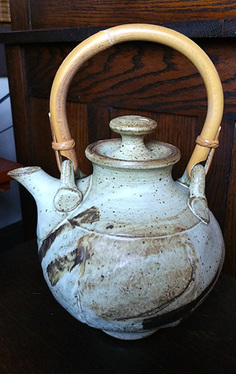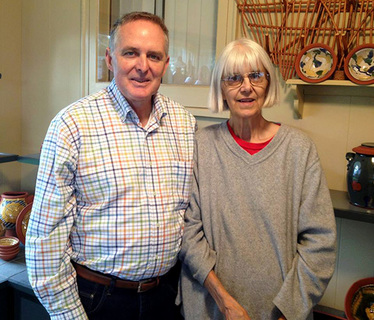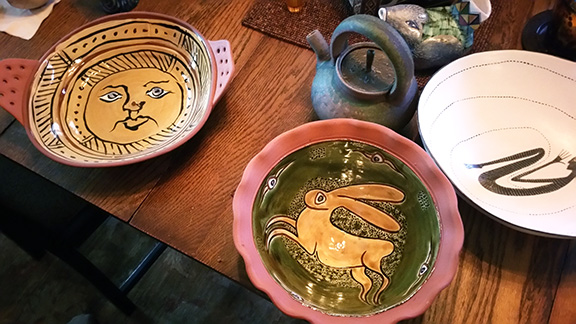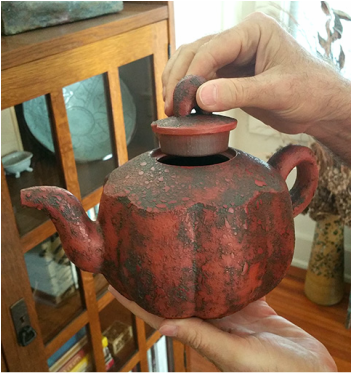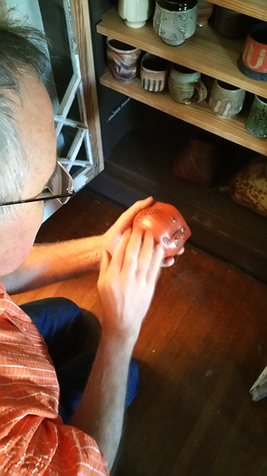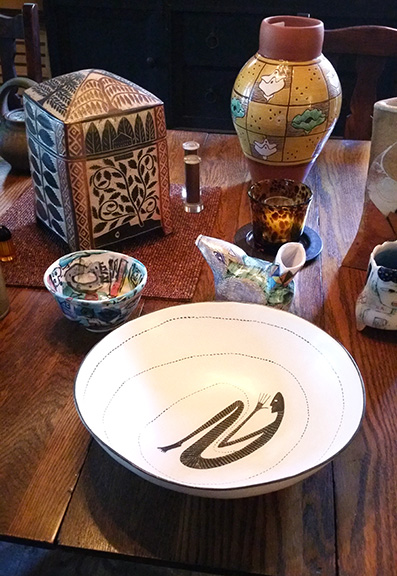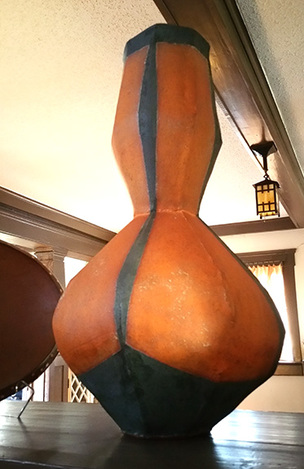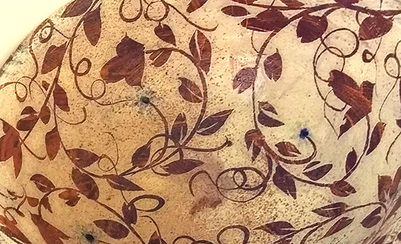|
To start off the New Year, we thought we would take a slightly different approach to January’s “Artist Spotlight.” Michael Brannin is a former potter from the Midwest during in the 70’s and 80’s turned Savannah real estate agent and ceramic collector. Even though he is not a current Savannah artist, we thought it would be good to have insights from a past full-time potter who is passionate about owning ceramics in his home. With his collection spanning between 500-600 individual pots, we were excited to experience and learn more about the ceramics at his home. Here’s a glimpse into how his collection first started. Michael Brannin, a native of California, was 17 years old when he graduated from high school. Having studied art his final semester and worked with ceramics and wood, he took the opportunity to relocate at a young age to Iowa to be a woodworker’s apprentice. The woodworking studio was in a renovated dairy barn that also housed a pottery area, a showroom, and an outdoor double chamber gas kiln. Michael spent a year woodworking, but he felt as if clay may be a better fit for his career; so at that same studio, he arranged to rent out a potter’s wheel and space to work.
While his career was growing in the restaurant business, Michael’s love for pottery never really went away. With Iowa City being home to the University of Iowa —which had a strong ceramics program during the time and a new gallery called AKAR, Michael was able to plug into classes or workshops and stay current with the latest work from many ceramic artists. He remembers, “When AKAR gallery opened, it was a very small space and could only display a few pots, but now that gallery has just exploded. I used to be privy to a select showing there before the exhibition opened to the public, and that’s how I have a few Ron Meyers pieces.”
Michael continued to buy ceramics, but wasn’t very disciplined. He began to focus on collecting Fiestaware pottery, but when that collection grew to 1500 pieces—including all four place settings in all 11 original colors, serving pieces and other rare pieces, he decided that he should shift back to collecting handmade pottery. In 2001, he successfully sold his collection on E-bay, and says, “I’m glad I sold it when I did, because I felt like I needed to get back to what truly interested me. I decided to turn that money into another investment in pots, and I became a more avid collector through that income.” That was right around the time when he met his partner, Craig Simpson, and when AKAR gallery moved to their new, larger show space. He and Craig would visit shows and pick pieces out, which is something he misses about Iowa City, because he’s never found that here in Savannah.
I would always go to her studio, spend a couple of hours looking, and we would chat and I would buy a couple of pots, so that’s how over the years we’ve amassed at least 300 of Clary’s pots.” Michael and Craig were seeking a change and perhaps warmer weather, so after a visit to Savannah in 2005, they decided to move. Michael acquired his realtor's license after some unsuccessful job searches, and even though he had never done real estate before, soon he and Craig became a real estate team. It wasn’t an easy transition, especially after the market crashed, but after a merger with Seabolt Brokers LLC, his business has grown and seen more success. Michael has considered working on pots again in his spare time—being able to make pots for himself and not worry about making a living off of his artwork, but "there’s the fact that people [in Savannah] just don’t get clay, don’t understand it locally or maybe haven't been exposed to it much. We don’t have a historical collection here, so there’s just not a culture here for that."
Michael still has his wheel, wedging table, electric kiln and pretty much all his tools and brushes, which are stored in the sun room of his home, but it's still a progress to find time. He thinks, “If I were to make pots today, it would probably be construction work. I found that most interesting, and if I were hand building my mugs, I may like them more. I guess that I would be starting off where I left, although my vision is a little different because of the exposure to such good nationally known artists; it really changes your eye and mind about what is what. We had such a great discussion getting to know Michael, but there was a lot more to discover. We had many questions about his collection and wanted to know more about the psychology of his process. It’s always encouraging to know that there are people in our Community who are non-makers, but are still passionate about supporting ceramic artists, so I hope you will enjoy the rest of our conversation. How many pots do you have in your collection? I’ve been trying to catalogue them. I know I have over 300 Clary pieces, and well over 150 yunomi, so would guess as many as 500-600 pots. Most of our collection is functional, or at least has an allusion to function. What’s your motivation for collecting ceramics, and maybe not wood? I do collect a variety of things, and that’s probably my down fall. I've always had an inquisitive mind in design and art from different periods. I am a little picky and mostly can’t afford the things I would mostly like to own, but I have been able to buy a few things over time, including a little wood. If I were a little more established, I probably could have owned a Nakashima table or piece when they were affordable, but now they’re not. What type of design and aesthetic are you drawn to in art and architecture? Do you find these styles are reflected in your purchases? Most of the art and design that appeals to me is a certain level of craftsmanship, and my background is steeped in handcrafted and handwoven things. The looser aesthetic was all the rage when I was learning, so that became a large influence on me. Whereas now, the younger generation is looking more towards the 50's and 60's, when there was a bright use of color—reds, floral and all that. It’s not that I’m opposed to those kinds of things, they just don’t seem to end up landing and fitting into my life for a long time, but they’re growing on me. Your first purchases, who were they? My first purchase was little stoneware statue making a peace sign that I bought when I was doing pottery in high school. I left it in California when I moved to the Mid-west. After that, I would periodically trade with people when I was making pots. I did buy a couple of Warren MacKenzie's pots back in ‘73 or ’74, and a Ruth Duckworth salt cellar at the 57th Street Art Fair in Chicago.
What’s your interaction with the pots you own? Do you use them? We have so many it would be nearly impossible to use them all, so they’re just kind of around. Though, we do entertain here quite a bit. We bring out pots from our collection, and for special occasions like Christmas dinner, I bring out our big chargers made by Clary. We're always careful, because we don’t want someone to go “clunk, clunk, clunk” with a spoon, and there are certain pots we’ll put out with a wooden spoon. I have another Kirk Mangus piece that is really great with cranberry sauce in it, but that's one of those that gets a wooden spoon. Pots and food always go hand-in-hand. Because of your experience in the restaurant, do you like to cook? Actually we do. Craig actually used to own his own restaurant, and I tend to be more about presentation. He always says I make things look pretty, but I do like to cook. Some of our guests will pick up on the fact that these are handmade dishes, and usually do comment on them, but you know they don’t have the same kind of experience, connection or exposure. Pots are overlooked to some extent here, as in most areas. Perhaps, the fact that I used to make pots changes the way I look at them, and lends me a different eye than someone who is not a potter or maker.
When I experienced my "dead end" as a potter, I didn’t see a way around it, although if I would have looked a little harder and deeper, I think I would have gotten past that. Being a potter is not for everyone, and I’ve known potters who have come and gone, but you have to keep it fresh, alive and interesting, which Clary has done. At some point, I think the gift to herself was not doing dinner sets; they are very difficult because of the major loss and all that. Sometimes that may mean not taking commissions any longer in order to be able to do your own things. You just have to find a way.
MacKenzie really espoused keeping pots low, and there is a merit to that, because it gets pots in people’s hands where they start appreciating them. Just look at what’s happened in Minnesota with the large sale there, the St. Croix Valley Pottery Tour. However, you also have to consider that Warren taught, so he had a second income. A lot of artists need things like health insurance, and that does make a difference. Clary really strove to do good work; she did workshops or two, but she tried to keep her prices so that people would buy them. In the end, she developed a good following. When I was doing pots, my cups were $3, but that was in the early 70’s. My teapots were maybe $30 or $35, which was quite a bit then. It is what it is. Do you find that you’re attracted to looser forms of other people’s work in your collection? No, not really. That’s the interesting thing. This is a Robert Archambeau teapot with a bronze lid [points to pot]; his pots are also kind of tight, but they have a natural quality. I love Ron Meyers, and almost all of his pots are loose, but that’s what he’s going for. Some people can do it so naturally that it comes off wonderfully. This is a Kirk Mangus [holds up pot]. He did these kind of brutalist forms that were loose. He was very well informed as far as ceramic history, and I bought this piece from a show that had already been sent, right about the time he died. I find that in the collection now, what I want is variety, some depth and breadth of types of work, almost like a teaching collection for me, like 'what are the possibilities with clay?'
Do you have that response to all the pots you own or only some of them? What is it like? Interestingly, Malcolm Davis had a show at AKAR, but he had a couple of terrible firings. The shino just didn’t do what it was supposed to do. So Malcolm was trying to cancel the show, but one of the owners pulled some things from his own collection. I was going to buy a vase, but the owner really encouraged me to buy one Malcolm's jars. It wasn’t that I wasn’t attracted to it, I just was trying not to spend that much money, but he talked me into buying that piece. Now, when you google Malcolm Davis, one of the first images that pop up is of one of those jars that I own. Maybe I’ve become a little thriftier over time. I can usually pick out pots pretty quickly, but when I was at Clary’s last time, I had a hard time. There were a couple of things I picked up right away, but she had just been to a sale, so she didn’t have as much. Usually, I can size things up pretty quickly. For instance, Lisa Bradley’s work, it’s still taken me awhile to warm up to the candy cane kind of colors, but I really liked the pots at the "Savannah Clay: 2015." One in particular, all white-on-white, I strongly considered and still would like to own, but I’ve been trying to focus on buying here and there and not spending too much money. At this point have you ever considered the pots leaving your intimate space into a potential, future "Savannah Craft Museum?”
I’ve wondered about that. I think at this point what Savannah needs in order to benefit the clay community is a really good show of good work somewhere, perhaps the Telfair. They had a show a few years back about Carolina potters, historic face jugs and other things. I feel that people just haven’t been exposed to pots here, and that’s why they don’t get it. After the exposure, things may change a little bit. I do find that people here are more interested in silver and ornate things, so perhaps pots that have more going on the surface and color might draw in some of those people.
3 Comments
doreen Edmondson
1/14/2016 12:53:43 am
Michael, I so love your collection! Some pieces just make me drool!! w Wouldn't that be a sight!!
Reply
Les Bendtsen
7/2/2016 10:31:48 am
Never mind Michael's collection, his own works were stunning! I have a Brannin covered vase purchased by my friend Richard Hillstrom in Minneapolis in 1974, and gifted to my husband by him. It's a favorite piece and shows tremendous artistry and skill.
Reply
Michael Brannin
7/25/2016 12:59:49 pm
Wow, what a blast from the past. I only attended the Minneapolis art fair once, that was early on in my pottery career. How nice to hear that a vase of mine is so well loved and appreciated! Thank you!
Reply
Leave a Reply. |
